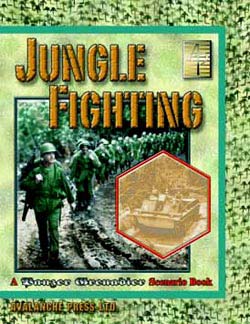| Jungle Fighting:
Publisher's Farewell
By Mike Bennighof, Ph.D.
December 2014
 For a book that sold so many copies, we sure shorted Jungle Fighting on website love. For a book that sold so many copies, we sure shorted Jungle Fighting on website love.
This is the first piece of Daily Content we’ve run purely devoted to our book of scenarios covering the U.S. Army’s role in the Guadalcanal campaign. It pre-dates Daily Content as a feature; we ran a piece on the British 25-pounder artillery piece that included a tiny download for Jungle Fighting (the U.S. Marines actually used a few on Guadalcanal) but that one tied in to multiple Panzer Grenadier games.
Jungle Fighting came out when we were still trying to figure out this whole core-supplement idea for our game series, and it’s a model we probably should have followed more often (and eventually did). It adds scenarios to one game, Guadalcanal, by using pieces from another, Battle of the Bulge. The book has a good cover design calling back to the Guadalcanal cover, which is a good marketing hook. Unfortunately we never really decided if we should market Jungle Fighting as a product in its own right, or if it was a means to market Guadalcanal (that sounds like a very tiny distinction, but it makes a huge difference in how you handle things).
We’ve put Jungle Fighting on sale a number of times, but that’s not because it sold poorly. We vastly overprinted it, due to the allure of cheap Asian printing in the early 2000’s and inexperience with sales ratios of core games to supplements. With Guadalcanal now permanently out of print, we’ll sell off the book in our Viking Funeral Sale and then dispose of whatever’s left over. This month is the last call for Jungle Fighting, and all the Viking Funeral Sale items.
So what was in this neglected book?
Brian Knipple, designer of Guadalcanal, turned it out in a fit of high-intensity writing and game design (this sort of madness strikes every now and then). It’s built around 42 scenarios that follow the campaign from the arrival of Army troops on Guadalcanal to the end of the fighting on the island, plus some more Marine-centric ones that weren’t included in the original game. They’re a major addition to Guadalcanal and do a great deal to fix what I always saw as Guadalcanal’s chief weakness, the relatively small number of scenarios.
The game has 24 of them, which is twice as many as you’ll get in tactical games from most other publishers so it may seem odd to call that out as a weakness. We issued the Guadalcanal game with so-called “historical” maps (though I never liked that term), which showed the actual terrain of the battlefields instead of the generic “geomorphic” maps we use in most other Panzer Grenadier games. So some of those 24 scenarios are small, or take place on unusual battlefields (like the tiny island map for Tulagi). Players actually seem to like weird scenarios – to play once. After that, they want more traditional engagements where both sides get to move and fight and have a chance to win outright (rather than take a few extra turns to get exterminated).
Jungle Fighting fixes that, by bringing a bunch more “normal” scenarios to the game table. Unfortunately it sometimes uses the “historical” game maps to represent different locations on the island. We didn’t have the production flexibility back then that we do now, or else I’d have given Jungle Fighting a couple of new geomorphic jungle maps to handle that problem. Those scenarios actually work pretty well on the Guadalcanal maps, but I just don’t like saying the map represents a particular location and then saying “now pretend it’s somewhere else.”
This wouldn’t be a problem today: the Matanikau and Tenaru maps could probably be replaced by geomorphic maps that had very similar features but could be used in more situations. We’ve done it in games since – one of the Desert Rats maps is a Sidi Rezegh map, and one of the Elsenborn Ridge maps is the area around the Twin Villages. And with the terrain massaged just a little to work with other geomorphic maps (so the roads exit at the right places, terrain features aren’t suddenly chopped off) they work just as well as if they’d been designed as “historical” maps. Then we could just add the specialty maps (the little islands). Unfortunately we hadn’t hit on that solution at the time Guadalcanal was designed: it’s so stupidly simple, it took a while for us to figure it out.
With Jungle Fighting added, Guadalcanal gains enormously more play value, as those odd scenarios become a much smaller proportion of the whole. It also gives a fuller historical perspective of the campaign, as the Marines’ fighting was only part of the story. Now the scenarios run all the way to the Japanese evacuation of the island, with the last of them taking place on 30 January 1943 (the last Japanese soldier left nine days later).
Guadalcanal has sold out and won’t be reprinted. If you’re lucky enough to own it, Jungle Fighting is a must-have addition. When the Viking Funeral Sale ends, we'll send Jungle Fighting permanently to Valhalla.
Click here to pick up Jungle Fighting while you still can!
Mike Bennighof is president of Avalanche Press and holds a doctorate in history from Emory University. A Fulbright Scholar and award-winning journalist, he has published over 100 books, games and articles on historical subjects.
He lives in Birmingham, Alabama with his wife, three children and his dog, Leopold.
|
